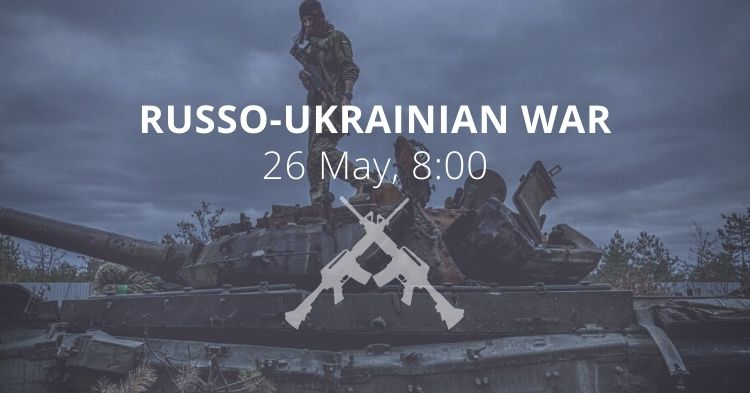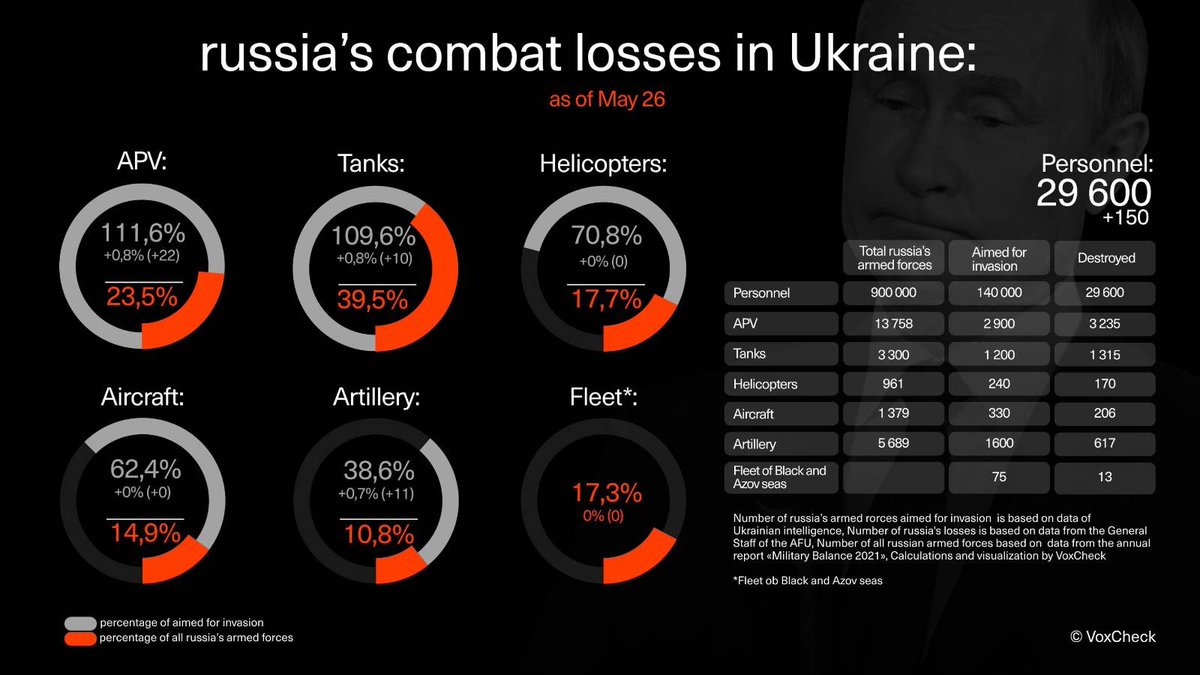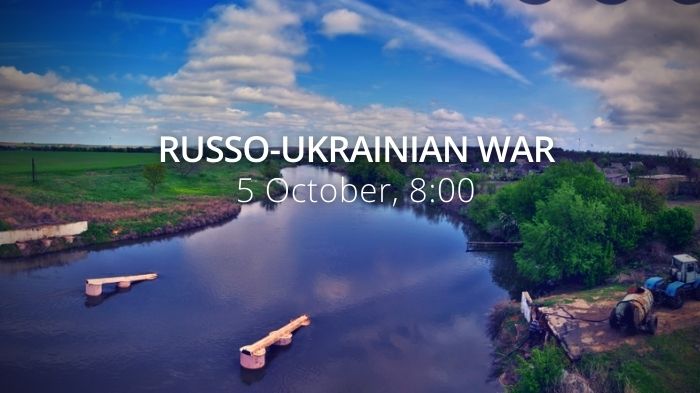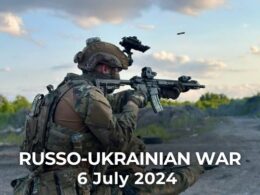Ukraine controls only 5% of Luhansk Oblast as Russian troops approach the region's key city of Sievierodonetsk. Russian attacks targeted the areas of Donetsk Oblast's Soledar, Lyman, Avdiivka, while Russia seeks to resume the offensive from Izium towards Sloviansk.
Ukraine seeks Marder vehicles and Leopard tanks from Germany. Russian parliament scraps age limit for army recruits. Russia's war in Ukraine may trigger a global recession. The West establishes a group to help Ukraine investigate war crimes.
Situation
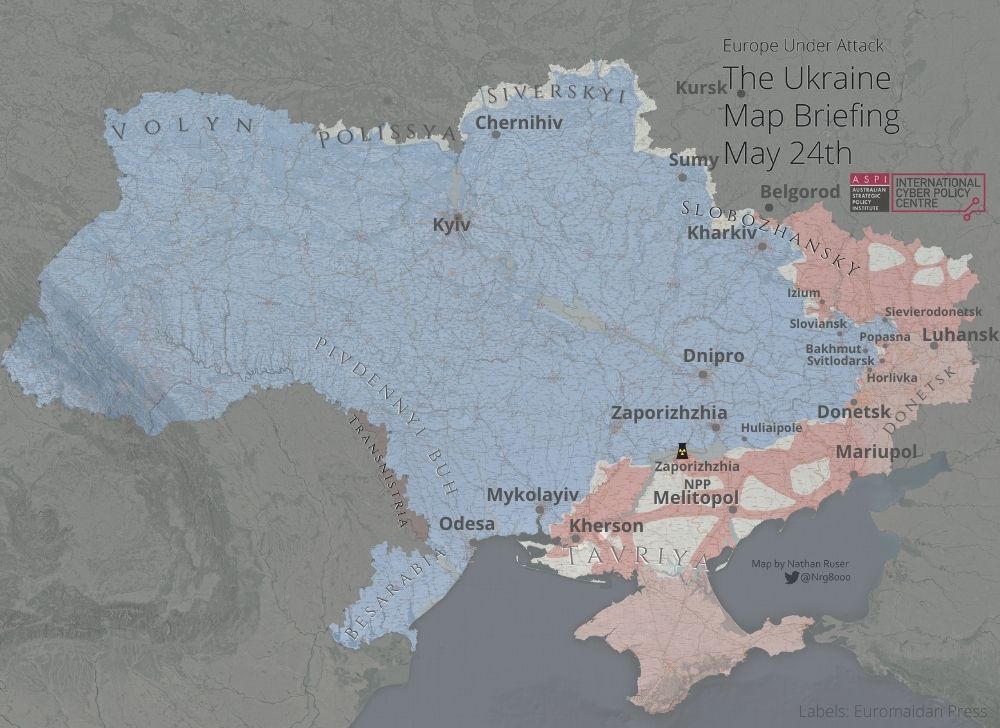
A short overview of developments at the front as of the evening of 25 May 2022 according to military expert Roman Ponomarenko:
Luhansk Oblast remains the hottest spot of the war. On the morning of 25 May, there were reports that Russian troops had cut off the Bakhmut-Lysychansk route near the villages of Bilohorivka and Nahirne. Later Luhansk Oblast Head Serhii Haidai refuted these reports. The highway is in the range of Russian fire and saboteur-reconnaissance groups are operating around it, yet a humanitarian convoy managed to pass through this highway. Ukraine's General Staff says that Ukrainian forces pushed off Russians from this road near the villages of Berestove, Lypove, and Nyrkove.
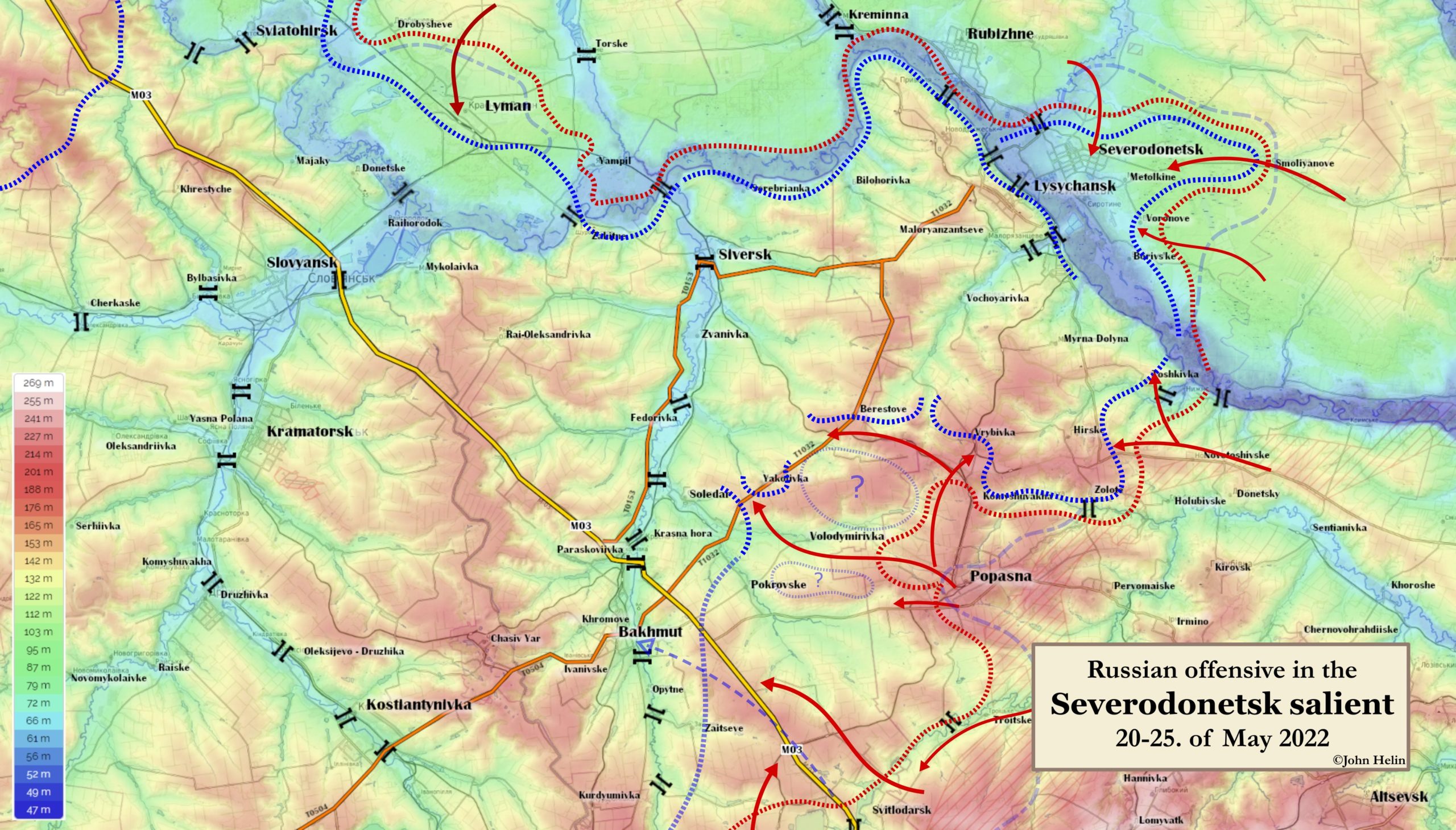
Russian forces approached Sievierodonetsk, fighting on the city's outskirts and shelling it with mortars. The National Guard's Rapid Response Brigade (unit 3018) defends Sievierodonetsk, whose fighters recorded a video address yesterday in which they promise to stand until the end.

South of Lysychansk, the Russians claimed the capture of Toshkivka, the village contested for several days now. Battles are ongoing for Novozvanivka south of occupied Popasna and for Komyshuvakha to its north.
There's fighting on the outskirts of Soledar, Donetsk Oblast near the villages of Nova Kamianka and Striapivka.
"The general situation in [Luhansk Oblast] is very difficult, but not catastrophic. Ukraine's heroic Armed Forces hold off the pressure of the enemy's overwhelming forces. Despite the considerable resources used by enemy generals, they cannot break through our defenses and the pace of their advance is slow. Only in places do [the Russian troops] push [the Ukrainian] troops out of positions, but the latter dig in again at the first opportunity and meet the enemy with fire on a new frontier and it all starts over," Ponomarenko wrote.
A potential threat is a Russian possible crossing of the Siverskyi Donets near Yampil, Serebrianka, or Bilohorivka, in order to deal a blow southwards to meet the Russian troops advancing north from Popasna. The potential primary Russian target is Siversk.
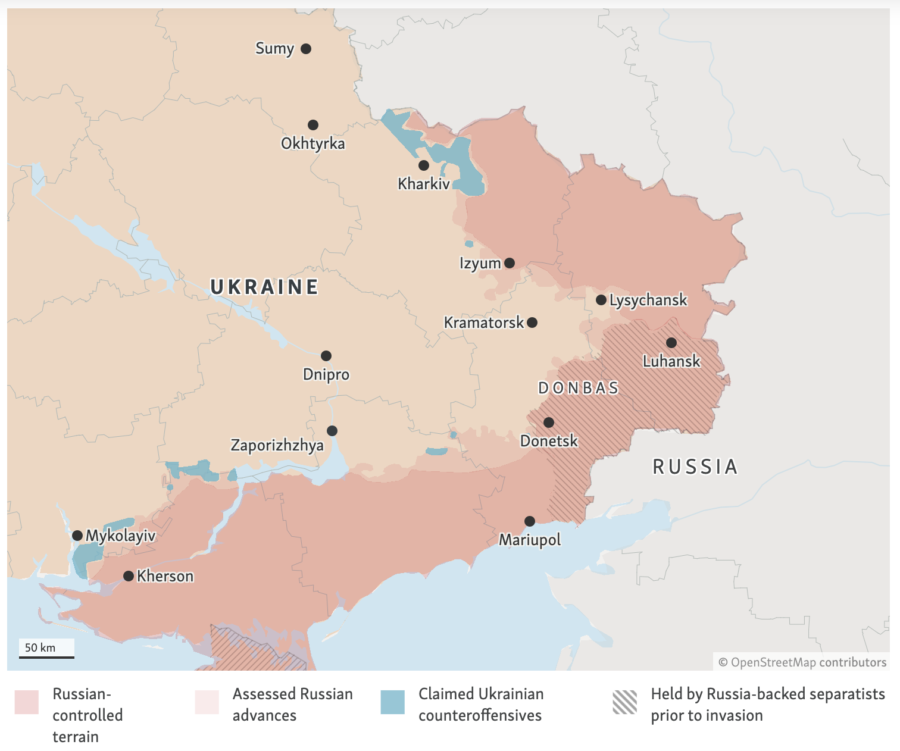
Medium-intensity fighting continues in the area of Izium and Sloviansk on the border of Kharkiv and Donetsk oblasts. The Russians carried out an unsuccessful attack near the villages of Dovhenke and Bogorodichne. They concentrated their artillery near Izium, in particular, the Russian 45th Artillery Brigade's two 203-mm 2S7 Pion guns and two self-propelled 240-mm 2S4 Tyulpan mortars. Russians also pulled up MLRS unit here. This shows that the Russian forces are going to launch a massive offensive from Izium to Sloviansk. The main question is whether it will start after the battle for Luhansk Oblast or earlier.
Fighting for Lyman continues east of Sloviansk. Since the Russians repeating yesterday what they said a day before that they "captured half of Lyman," this shows that their assault has slowed down.
Near Donetsk, the Russians again tried to forward their advance on Kurakhove, attacking the areas neat Krasnohorivka, Kamianka, Avdiivka, and Pisky, but had no success as per the available data.
Reports on local clashes come from Kharkiv, Zaporizhzhia, Mykolaiv, and Kherson oblasts. In the two latter oblasts, Russians try to get closer to Mykolayiv and the borders of Kherson Oblast but allegedly without much success.
In general, Russia conducts massive attacks only in Luhansk Oblast. Other sectors see either positional battles or not very convincing Russian attempts at attacking.
Morning report day 92 – May 26
The report is based on media reports, expert analyses and official information posted online. According to information from the General Staff as of 06.00 26.05.2022, supplemented by its [18:00 assessment] is in the drop-down box below.
[The main focus of Russian forces is on the defeat of the Joint Forces and attempts to establish full control over the territories of Donetsk and Luhansk oblasts. Here the enemy tries to overcome the resistance of the units of the Joint Forces to create favourable conditions for the offensive. Russian forces focused their main efforts on the Bakhmut direction. It is trying to develop success in the Lyman direction. In addition, Russian occupiers continue to actively prepare for offensive operations in the Novopavlivsk and Zaporizhzhia areas.]
Command and staff and mobilization exercises are being held in the Volyn and Polissia directions with the personnel of the military units of the Armed Forces of the Republic of Belarus. The probability of missiles and airstrikes from the territory of this country remains.
- [At the end of May this year, practical actions of units of the Armed Forces of the Republic of Belarus are planned at the training grounds in Brest, Vitebsk, Grodno, Minsk, and Mogilev regions. According to available information, the plan of these measures envisages the withdrawal of weapons and military equipment and the implementation of marches.]
- The consequences of the deployment of units of Russian forces involved in hostilities on the territory of Ukraine on the territory of the Republic of Belarus are being eliminated. Measures are being taken to prevent the illicit trafficking of weapons and ammunition that could be lost by Russian troops.
In the Siverskyi direction, Russian forces are taking measures to cover the Ukrainian-Russian border in the Bryansk and Kursk oblasts and to prevent the transfer of our troops to other threatening areas.
- In the border areas of these Russian regions, the increased level of a terrorist threat has been extended until June 8 this year.
- The enemy fired 120-mm mortars and artillery shells at the settlements of Bachivsk and Krasnopillya in the Sumy oblast and the Zarichche settlement in the Chernihiv oblast.
In the Slobozhanskyi direction, Russian forces carry out a systematic high-intensity fire in the areas where our troops are concentrated. It also fired on civilian infrastructure in the areas of the settlements of Ternov and Cherkasy Tyshky. [Yesterday, Russian forces fired on civilian infrastructure in the settlements of Krasnopillya in Sumy oblast, as well as in Ternove, Ruski Tyshky, Dovhenke and Nova Dmytrivka in the Kharkiv oblast.]
- Russian forces are trying to improve the tactical situation in the Izium direction and resume the offensive on the city of Sloviansk. It fired artillery, rocket-propelled grenade launchers, mortars, and tanks at the settlements of Chepil, Dovhenke, Kurulka, Bohorodychne and Studenok.
- [Yesterday, they made attempts at assault and offensive operations in the districts of Dovhenke, Kharkiv oblast and Bohorodychne, Donetsk oblast, had no success and withdrew.]
In the Donetsk direction, Russian forces' main efforts are focused on taking full control of the settlement of Lyman and trying to improve the tactical situation near Sievierodonetsk and Avdiivka. Russian forces are actively using electronic warfare in the Bakhmut and Avdiivka directions. It used artillery and assault aircraft and the Russian forces are trying to gain a foothold in the area of Sievierodonetsk. It carried out assault operations in the direction of the settlement of Ustynivka but had no success. [Yesterday, Russian forces inflicted artillery and airstrikes in the Lyman and Komyshuvakha districts of the Donetsk oblast and Sievierodonetsk and Novozvanivka in the Luhansk oblast.]
- Fighting continues in the Bakhmut direction. Russian forces unsuccessfully attempted an offensive in the Komyshuvakha, Lypove, and Nahirne districts.
- In the Avdiivka direction, Russian occupiers carried out assault operations in the Krasnohorivka, Kamianka, Avdiivka, and Pisky districts, but were unsuccessful.
- In the Novopavlovsk direction, Russian forces attempted an offensive in the area of the settlement of Zolota Niva but withdrew with losses.
- In the Zaporizhzhia direction, the enemy fired artillery at the areas of the settlements of Novopil, Charivne, Orikhove, and Kamianka.
- During the past 24hrs, ten enemy attacks were repulsed in Donetsk and Luhansk, four tanks, two artillery systems, an armored personnel carrier, a car and one unit of special equipment were destroyed. Air defense units destroyed five Orlan-10 UAVs.
[In the Pivdennyi Buh direction, Russian forces units tried to improve the tactical position in the direction of Mykolayiv and ensure access to the administrative borders of the Kherson region.] It carried out assault operations in the area of the settlement of Tavriyske but had
no success.
- In the Kryvyi Rih direction, Russian occupiers unsuccessfully tried to carry out assault actions around the settlement of Mykolayivka. Civilian infrastructure was shelled near Osokorivka, Trudoliubivka and Dobrianka.
- Russian forces continued the engineering equipment of positions in the areas of settlements Chornobaivka, Pravdyne, and Zoria.
- [Russian forces fired on the positions of Ukrainian troops and civilian infrastructure in the areas of Novooleksandrivka, Trudoliubivka, Novopavlivka, Blahodatne, and Posad-Pokrovskyi.]
Strike aircraft of the Air Force of the Armed Forces of Ukraine struck at enemy positions - destroyed personnel and up to ten units of light armored vehicles. Our fighters intercepted and shot down two cruise missiles.
[Russian forces continue to suffer losses of personnel and military equipment. Information is regularly received about the concentration of a significant number of wounded servicemen of the armed forces of the Russian Federation in medical institutions of settlements bordering on Ukraine.]”
Luhansk Military Administration: 95% of Luhansk Oblast is occupied, the situation in Donbas is critical, the Ukrainska Pravda reports. Serhii Haidai, Head of Luhansk Oblast Military Administration, wrote on Facebook that 95% of the oblast’s territory has been occupied by Russian troops.
“According to him, the situation in the Donbas is critical. According to Haidai, the Lysychansk-Bakhmut road is under constant Russian fire. On 24 May, a Russian sabotage and reconnaissance group was able to enter the road and set up their checkpoints. However, as of 25 May, the road is not blocked and it has been possible to deliver humanitarian cargo to Ukrainian-held parts of Luhansk Oblast.”
“Haidai added that Sievierodonetsk has not been encircled and that 15,000 civilians remain in towns and villages around the city. Overall, more than 40,000 civilians remain in the Ukrainian-controlled territory of Luhansk Oblast; according to Haidai, 99% of them do not want to evacuate.”
Ukrainian Ministry of Defence: Russian bombers looking for Ukrainian air defense positions, the Ukrainska Pravda reports. Russian military command has intensified the use of long-range and strategic bombers to detect Ukrainian air defense systems, said Oleksandr Motuzianyk, Defence Ministry spokesman.
"The aggressor is conducting intense fire along the front line and into the depths of the Ukrainian defense in Luhansk and Donetsk oblasts. The enemy has intensified the use of aviation, especially assault and army aviation to support its ground offensive. Russian use of long-range and strategic bombers continues to expose the air defense systems of the Armed Forces of Ukraine and to define new boundaries for the launch of cruise missiles on the territory of our state.”
According to British Defence Intelligence, (last 24 hours):
- Russia’s airborne forces – the VDV – have been heavily involved in several notable tactical failures since the start of Russia’s invasion. This includes the attempted advance on Kyiv via Hostomel Airfield in March, the stalled progress on the Izium axis since April and the recent failed and costly crossings of the Siverskyi Donets River.
- Russian doctrine anticipates assigning the VDV to some of the most demanding operations. The 45,000-strong VDV is mostly comprised of professional contract soldiers. Its members enjoy elite status and attract additional pay. The VDV has been employed on missions better suited to heavier armored infantry and has sustained heavy casualties during the campaign. Its mixed performance likely reflects strategic mismanagement of this capability and Russia’s failure to secure air superiority.
- The misemployment of the VDV in Ukraine highlights how Putin’s significant investment in the armed forces over the last 15 years has resulted in an unbalanced overall force. The failure to anticipate Ukrainian resistance and the subsequent complacency of Russian commanders has led to significant losses across many of Russia’s more elite units.
As of Thursday 26 May, the approximate losses of weapons and military equipment of the Russian Armed Forces from the beginning of the war to the present day:
Russian enemy suffered the greatest losses (of the last day) in the Avdiivka direction.
Russian parliament scraps age limit for army recruits, the Reuters reports. “Russia's parliament approved a law on Wednesday in double-quick time removing the upper age limit for contractual service in the military, amid heavy casualties in Ukraine. Currently, only Russians aged 18-40 and foreigners aged 18-30 can enlist as professional soldiers in the Russian military”.
Russia can no longer actively use Iskander launchers - Polish expert, the Ukrinform reports. “The deployment of Iskander-M short-range ballistic missile launchers to the Brest region of Belarus does not mean they can be actively used against Ukraine, as Russia now does not have a large number of missiles for these systems. Waldemar Skrzypczak, former commander of the Polish Land Forces and former deputy minister of national defense, said this in a comment to Ukrinform. "The Russians do not have many Iskanders, so they will save them. The deployment of launchers does not mean anything, because you need to have missiles for them. They have already used a lot of missiles. I don't think they have significant reserves," Skrzypczak said.”
Humanitarian
The multi-layered violations of cultural rights in Ukraine will have devastating effects in the post-war era, a UN human rights expert warned today.
“As in other conflicts, we currently witness the unfolding of suffering in Ukraine that does not seem to end and we cannot stop,” said Alexandra Xanthaki, Special Rapporteur on cultural rights. “The questioning and denial of the Ukrainian identity and history as a justification for war is a violation of the Ukrainians’ right to self-determination and their cultural rights. Self-identification is the paramount expression of these rights and all discussions, by States and in social media, should respect this.”
The expert said that the considerable loss of cultural heritage and destruction of cultural artifacts was worrying for the identity of both Ukrainians and minorities within Ukraine and would impact the establishment of a peaceful multicultural society after the end of the war.
According to UNHCR 6,642,659 refugees have been registered as of May 24. The UN says that so far Poland has taken in 3,544,995 refugees, Romania 972,203, Russian Federation 945,007, Hungary 654,664, Republic of Moldova 473,690, Slovakia 446,755 and Belarus 27,308. Among those who fled Ukraine are also Ukrainian nationals with dual citizenship. An additional 105,000 people moved to the Russian Federation from Donetsk and Luhansk oblasts between 18 and 23 February.
The number of Ukrainians entering Ukraine since February 28 is 2,120,500 as of May 24. This figure reflects cross-border movements, which can be pendular and does not necessarily indicate sustainable returns.
OHCHR recorded 8,628 civilian casualties in Ukraine as of May 24. 3,974 were killed (including 259 children) and 4,654 injured (including 402 children).
Environmental
World Bank's Malpass says the war in Ukraine may trigger a global recession, the Reuters reports. “World Bank President David Malpass on Wednesday suggested that Russia's war in Ukraine and its impact on food and energy prices, as well as the availability of fertilizer, could trigger a global recession.
Malpass told an event hosted by the US Chamber of Commerce that Germany's economy, the world's fourth-largest, has already slowed substantially due to higher energy prices and said reduced production of fertilizer could worsen conditions elsewhere. "As we look at the global GDP ... it's hard right now to see how we avoid a recession," Malpass said. He gave no specific forecast.
He said the economies of Ukraine and Russia were both expected to see a significant contraction, while Europe, China, and the United States were seeing slower growth. Developing countries were being hit even harder given shortfalls of fertilizer and food stocks and energy supplies, he said.
"The idea of energy prices doubling is enough to trigger a recession by itself," he said.
In China, he said the relatively sharp slowdown in growth was based on the COVID-19 pandemic, inflation, and the pre-existing real estate crisis the country had been facing.
The World Bank last month had already cut its global growth forecast for 2022 by nearly a full percentage point, to 3.2% from 4.1%, due to the impacts from Russia's invasion of Ukraine.”
Legal
Blinken: West establishes a group to help Ukraine investigate war crimes, the Ukrinform reports. “The United States, the European Union and the United Kingdom announced the creation of the Atrocity Crimes Advisory Group (ACA) to investigate Russia’s atrocities in Ukraine. According to the press release published by the US Department of State, the joint initiative will support the Office of the Prosecutor General of Ukraine (OPG) in its investigation and prosecution of conflict-related crimes.
The ACA seeks to streamline coordination and communication efforts to ensure best practices, avoid duplication of efforts and encourage the expeditious deployment of financial resources and skilled personnel to respond to the needs of the OPG as the legally constituted authority in Ukraine responsible for dealing with the prosecution of war crimes on its own territory. According to the Office of the Prosecutor General, 13,748 crimes of aggression and war crimes have been registered in Ukraine to date.”
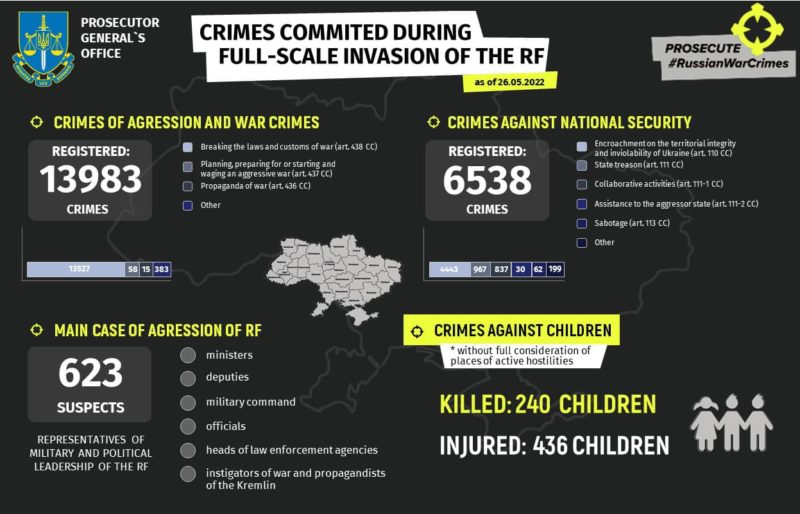
240 children were killed and 436 children injured, the Office of the Prosecutor General of Ukraine reports
as of May 26. 1,883 educational establishments are damaged as a result of shelling and bombings, 178 of them are destroyed fully. 13,983 crimes of aggression and war crimes and 6,538 crimes against national security were registered.
Support
Ukraine seeks Marder vehicles and Leopard tanks from Berlin, Kuleba says, the Reuters reports. Kyiv seeks to acquire German Marder infantry fighting vehicles and ideally also Leopard main battle tanks but has not made much headway with the government in Berlin so far, Ukraine's Foreign Minister Dmytro Kuleba said on Wednesday.
"Something that we think is feasible is these Marder armored vehicles and our dream, of course, is German Leopard tanks," he told a news conference on the sidelines of the World Economic Forum in Davos. "But we are not even close to, we are not there."
US provides $4M in new support for humanitarian demining in Ukraine, the Ukrinform reports. “This week the United States provided $4 million in new support to The HALO Trust in Ukraine to deploy 10 teams to clear Russian landmines and unexploded bombs so families can return home to their communities safely,” the US Embassy in Ukraine posted on Twitter. As reported, Deputy Interior Minister of Ukraine Meri Akopian said during a meeting of the International Coordination Center for Humanitarian Demining at the State Emergency Service of Ukraine that about 300,000 sq km of the Ukrainian territory needed to be demined due to the full-scale Russian invasion as of May 20. [In size, the area represents all of Italy or 84% of Germany.]
New developments
- EU cracks widen over Ukraine as Italy and Hungary urge truce, the Reuters reports. “Italy and Hungary have urged the EU to call explicitly for a ceasefire in Ukraine and peace talks with Russia, putting themselves at odds with other member states determined to take a hard line with Moscow ahead of a summit next week. A draft concluding statement for the May 30-31 summit, seen by Reuters and dated May 19, describes the European Union as "unwavering in its commitment to help Ukraine exercise its inherent right of self-defense against the Russian aggression." It does not mention peace talks.
At a meeting of EU envoys on Friday, Italy's ambassador proposed changes to the text saying it should refer to peace talks and set out an immediate ceasefire as one of the EU's first goals, according to people who attended the meeting. That proposal was backed by Hungary and Cyprus, which are among the states most critical of a new package of EU sanctions against Russia that has been blocked for weeks because of internal divisions”.
- Zelenskyy's associate pointed out the red line for Ukraine in the war, the Ukrainska Pravda reports. Mykhailo Podoliak, the Adviser to the Head of the Office of the President of Ukraine emphasises on Telegram that the surrender of Ukrainian territories, citizens or sovereignty to the enemy is impossible. In particular, they ruled out any "Minsk-3".
“We do not trade our citizens, territories, or sovereignty. This is a clear red line. Ukrainian society has paid a terrible price and will not allow anyone to take even one step in this direction – no government and no country. Any hint of this from any of our partners will receive a principled response. There can be no talk of freezing the conflict."
- Russia will agree to a ceasefire when it is one step away from defeat – Kuleba, the Ukrinform reports.
"We agree that a ceasefire is necessary, but I give you a 100% guarantee that when Russia agrees to a ceasefire, it will be the moment when it is one step away from its defeat in the war. And they will agree to a ceasefire for the sole purpose of escaping their defeat in the war and before that, the war will continue," [Ukrainian Foreign Minister Dmytro Kuleba said].
- Putin issues a decree: he will grant Russian citizenship to people living in occupied territories of Ukraine, the Ukrainska Pravda reports. President Putin has signed a decree on simplified admission to Russian citizenship for residents of the occupied territories of Kherson and Zaporizhzhia oblasts of Ukraine.
“Putin's new decree amended the text of a document issued in April 2019, according to which the Russian authorities made it easier for residents of the occupied areas of Donetsk and Luhansk oblasts to obtain Russian citizenship. As well as the occupied areas of Donetsk and Luhansk oblasts, the Kherson region and the occupied areas of Zaporizhzhia Oblast have been added”.
- Ukraine considers Putin's decree on Russian passports "null and void", the Ukrainska Pravda reports. “The Ukrainian Ministry of Foreign Affairs has condemned the decree of the President of the Russian Federation, which forces residents of the territories temporarily occupied by the Russian army in Kherson and Zaporizhzhia Oblasts to acquire Russian citizenship”.
- Zelenskyy supports the petition for a visa regime with Russia and instructs the Cabinet of Ministers to action it, the Ukrainska Pravda reports. The petition, "Establish a visa regime for citizens of the Russian Federation", was published on the President's website on 11 February 2022. The petition has been signed by almost 27,000 people. President Volodymyr Zelenskyy has supported the petition to introduce a visa regime for Russian citizens in Ukraine.
Assessment
On the War
The Institute for the Study of War has made the following assessment as of Wednesday 25 May:

The incident highlights a continuing shift in the Russian-language milblogger information space regardless of the video’s authenticity. Milbloggers would likely have either attacked or dismissed such a video loudly and in near-unison earlier in the war, when they all generally focused on presenting optimistic pro-Russian and anti-Ukrainian narratives. The response to this video in the Russian-language milblogger space demonstrates the strong resonance anti-Kremlin narratives can now have. It is impossible to know what effect this change in this information space might have on general perceptions of the war in Russia, but it is one of the most visible and noteworthy inflections in the attitudes of previously strongly pro-Kremlin ostensibly independent Russian voices speaking to Russians that we have yet seen.
Today’s statement by DNR Militia Head Eduard Basurin explaining that Russian forces would focus on creating “smaller cauldrons” rather than on a single large encirclement is likely in part a response to a critique that surfaced both in the milblogger space and in the Russian Duma that Russian forces had failed to form and reduce “cauldrons” of the sort they used in 2014. Basurin’s statement, along with other changes in the ways in which Russian officials have spoken about cauldrons and Russian operations in the east following those critiques suggest that the Russian and proxy leadership is sensitive to shifts in this information space.
Russian forces are increasingly facing a deficiency in high-precision weaponry. The Ukrainian General Staff reported that due to an increasing lack of high-precision weapons Russian forces are seeking other methods of striking critical infrastructure and have intensified the use of aircraft to support offensives. The Ukrainian Main Intelligence Directorate (GUR) noted that up to 60% of Russia’s high-precision stockpile has already been exhausted, which is consistent with previous reports by Western defense officials that Russian forces have been increasingly relying on “dumb bombs” because they are facing challenges replenishing their supplies of precision munitions in part due to sanctions targeting Russia’s defense-industrial production. A lack of high-precision weapons will likely result in an increase in indiscriminate attacks on critical and civilian infrastructure.
The Kremlin is attempting to expand the pool of Russian passport-holders in occupied areas. Russian President Vladimir Putin signed a decree on May 25 that will simplify the procedure for obtaining a Russian passport within Kherson and Zaporizhzhia Oblasts. This renewed campaign of so-called ”mass passportization” is occurring in occupied territories and likely represents an effort to set conditions for some sort of post-conflict political arrangement (the precise form of which Putin prefers remains unclear) through manipulating access to Russian citizenship. Occupation authorities may additionally attempt to exploit this new decree to carry out covert mobilization in occupied areas, as having a Russian passport would make conscription-eligible residents of occupied territories subject to forced military service.
The Kremlin and Russian military commanders are introducing new regulations aimed at addressing the diminishing level of combat-ready reserves. The Russian State Duma and the Russian Federation Council passed a bill raising the maximum age for voluntary enlistment into the Russian military from 40 to 50. Russian Telegram channels also reported that Russian leadership forced operational officers and commanders of the Russian Border Guards of southern Russian regions including Rostov Oblast and occupied Crimea to indefinitely cancel all summer vacations--a rather unsurprising step in light of the military situation in principle, but an indication of the next source of manpower to which Putin will apparently turn. Russian Border Guards will reportedly deploy to training grounds for unspecified exercises in late May. The Ukrainian General Staff also reported that Russian forces are forming new reserve units within the Southern Military District.
Key Takeaways
- Russian forces prioritized advances east and west of Popasna in order to cut Ukrainian ground lines of communication (GLOCs) southwest of Sievierodonetsk and complete encirclement efforts in Luhansk Oblast.
- Russian forces have likely entered Lyman and may use this foothold to coordinate with advances southeast of Izium to launch an offensive on Siversk.
- Russian forces may start the Battle of Sievierodonetsk prior to completely cutting off Ukrainian GLOCs southwest and northwest of Sievierodonetsk.
- Russian forces struck Zaporizhzhia City in an attempt to disrupt a key logistics hub for Ukrainian forces operating in the east.“
Zelenskyy: End of war depends on West’s position and Russia’s desire, the Ukrinform reports. The end of the war depends on both the West's united position on aid to Ukraine and Russia's desire to sit down at the negotiating table. "As for when this war may end, I think it depends on some things, specific things. First of all, on the desire of different parties," President of Ukraine Volodymyr Zelensky said during the Davos Ukrainian Breakfast, Ukrinform reports.
“First and foremost, he said, the end of the war depends on the desire of the united West not to be afraid to fight the Russian Federation. Moreover, according to the President, it depends on the desire of Russia itself.
"Because this war will end in any case and we understand that there is a ‘military’ part of the war (now is the tensest moment: a lot of blood of innocent people, civilians, a lot of military personnel losses). After the military part is over, I am sure there will be a peace process in any case and there will be a negotiating table and there will be peace. The question is whom Ukraine will negotiate with, the question is which Russian president Ukraine will negotiate with," Zelenskyy added.
The President of Ukraine stressed that the negotiation process also depended on the wishes of the incumbent president of Russia. Asked whether it is possible to negotiate with the incumbent president of Russia, Zelenskyy noted that Putin stayed now in his own information world and did not understand that Ukraine would not make concessions.
"We are fighting on our land and I emphasize that this is Ukraine's war not against anyone, but for itself, on its own land, for its own freedom. And precisely for its own future... And that is why he [Putin] must live in reality and his entourage must help him get out of his informational unreality which they have been building for many years, decades ... And so today we can only talk to the president of the Russian Federation as talks with any mediator do not make sense," Zelenskyy said.
According to him, the Ukrainian society also plays an important role, having seen the consequences of the actions of Russian troops in Ukraine and seeing what happens now in the occupied territories. "I think this desire [to sit down at the negotiating table] disappears with every passing day," Zelenskyy said.”
Russia's Air War in Ukraine is a Total Failure, New Data Show, the Newsweek reports. “Russia has fired more missiles in the Ukraine war than have been fired by any country in any other conflict since World War II—a record, according to air-warfare experts and new data obtained exclusively by Newsweek, that has failed to pay off for Moscow. […]
Long-range cruise missiles were also developed parallel with smart bombs, becoming the modern-day weapon of choice for sensitive American attacks, even as the cost (at over $1 million per missile) has limited their use. Over 32 years, some 2,300 Tomahawks have been used in combat, from punishing attacks on Saddam Hussein to "wag the dog" strikes in the former Yugoslavia to the 2018 attack on Syrian chemical weapons facilities.
That's about how many Russian missiles have been used in 85 days of strikes (2,275 missiles have been successfully launched as of May 23), an expensive and dubious undertaking for Moscow. Whether Russia's vulnerability to Ukrainian air defenses is responsible for Moscow's reliance on these (similarly expensive) long-range missiles, or it is more in the nature of Russian culture to use flying artillery, is still open to question. […]
"If you look at the launches overall, we are talking well under half of all Russian missiles hitting their aim points," says a senior Defense Intelligence Agency official who is working on the war. The official, granted anonymity to discuss sensitive information, says that two to three out of every ten missiles fired fail to launch or fizzle during their flight. Two more have technical problems such as not fusing properly even if they fly to their intended range. Two to three more miss their aim-points even when they reach their intended target.
"Right now, we're holding Russian missile success at just below 40 percent," the DIA official says. Ukraine says that it has shot down 110 Russian cruise missiles, almost 10 percent of those that make it into Ukrainian airspace. […]
Of the 20,000 or so sorties that the Russian air force has flown so far in the Ukraine war, fewer than 3,000 have entered Ukrainian airspace, almost all of them over the battlefield. Is Russia afraid of Ukraine's air defenses, or is this more or more or less intentional, that missiles were supposed to have been the predominant weapon and that they can be fired at long distance?
Consequences and what to do?
Don’t worry about Putin’s feelings. Russia must pay for its invasion, The Washington Post columnist Max Boot wrote on May 23.
“It’s been more than a month since Russian dictator Vladimir Putin, having failed to take Kyiv, launched
an offensive in the Donbas region of eastern Ukraine to salvage some glimmer of victory from his unprovoked war of aggression.
How’s that going? Well, Russia did finally take the southern city of Mariupol after the last defenders surrendered — not that there is much left of the city after the Russian bombardment. But Ukrainian troops have pushed the invaders out of artillery range of Kharkiv, Ukraine’s second-largest city, located only about 20 miles from the Russian border. The Russian offensive is now focused on Sievierodonetsk, one of the last remaining Ukrainian strongholds in the Luhansk region, which the Russians are trying to turn into the “new Mariupol.”
Overall, the Pentagon assesses Russian progress as “uneven” and “incremental.” To achieve such small gains, the Russians have suffered heavy losses, with the British government estimating last week that the invaders had lost a third of the 190,000-strong force that initially attacked Ukraine. One particularly spectacular Russian setback occurred during an attempted crossing of the Siverskyi Donets River in Donbas. Ukrainian artillery zeroed in on the Russian troops, leading to the loss of an estimated 485 soldiers and 80 pieces of equipment.
Even Putin is implicitly conceding that things have not been going according to plan by reportedly firing the general in command of the 1st Guards Tank Army, after its failure to capture Kharkiv and the admiral in charge of the Black Sea fleet after its flagship, the Moskva, was sunk by Ukrainian anti-ship missiles. The Kremlin is so strapped for manpower that is lifting age restrictions for new recruits. How long before they send a brigade of babushkas into Ukraine?
The Russian offensive appears to be petering out and a major Ukrainian counteroffensive is still to come. Retired Lt. Gen. Ben Hodges, former commander of the US Army Europe, predicts that the Russian army will collapse by the end of the summer and that Ukraine will reclaim all of the territory it has lost since the invasion began on Feb. 24. While that scenario may be over-optimistic, it is more likely than any kind of Russian victory.
But instead of celebrating the Ukrainians’ progress, many in the West are reacting with trepidation. French President Emmanuel Macron is warning that Russia must not be humiliated. Italy is circulating its own four-point peace plan. The New York Times editorial board is tut-tutting that “a decisive military victory for Ukraine … is not a realistic goal” and advising President Volodymyr Zelenskyy to give up land for peace.
This is faux-realism. Given that the world widely expected Kyiv to fall within three days of a Russian invasion, it is the height of hubris to say what Ukraine can or cannot achieve on the battlefield. Given the horrors that Russia has inflicted on the areas it has conquered — which include rape, murder, and deportation — it is the height of inhumanity to insist that Ukraine turn over any of its people to indefinite Russian occupation. And given that Russia has shown no sign of stopping the war or entering into serious negotiations, it is the height of wishful thinking to imagine that Ukrainian concessions now would bring the war to an end. More likely, Putin would view any preemptive concessions as a sign of faltering resolve and simply redouble his determination to outlast his enemies.
It is time to stop worrying about sparing Putin’s feelings. That is the mind-set that led to the invasion of Ukraine in the first place. Russia transgressed before — the invasion of Georgia in 2008, the seizure of Crimea in 2014, the bombing of Syria beginning in 2015, the attack on the 2016 US presidential election, the poisoning of dissidents in the West — and the West never really cracked down because of the assumption that we had to do business with Moscow. Enough mollycoddling. Russia must suffer such a devastating defeat that it will be many decades before another Russian leader thinks of attacking a peaceful neighbor.
What is everyone afraid of anyway? There is no conventional escalation that Putin can now undertake as a practical matter; his air force is being held back not by Russian restraint but by Ukrainian air defenses. The concern — let’s be honest — is that, if Putin is humiliated, he will go nuclear. But the chances of Putin nuking a NATO country and initiating World War III are infinitesimally small. If Putin uses a nuclear weapon it would be against Ukraine. The Ukrainians are willing to run that small risk to defend their country — and the entire civilized world — from an evil war of aggression.
We who sit safely and watch the war from the sidelines have no right to tell the Ukrainians what their war aims should be. We have a moral and strategic obligation to simply support them. The Ukrainians need more weapons from the West, including HIMARS rocket artillery and F-16 fighter planes. They don’t need lectures from second-guessers who claim to know better than they do what is in their own self-interest.”
Hans Petter Midttun’s assessment
Russia is in the process of turning Sievierodonetsk into a new Mariupol and is intensifying its indiscriminate bombing of civilians. Ukrainians are being exposed to rape, murder, torture, and deportation. More than 6,6 million have become refugees while more than 8 million persons are internally displaced. Over 1.4 million Ukrainians have been forcibly deported to Russia from occupied territories in Ukraine, including 240,000 children. More than 670 children have been killed or wounded. The UN has verified more than 8,500 civilian casualties, with the real numbers expected to be many times higher.
Ukraine is being destroyed as we watch, having suffered more than $1 trillion in damages. At least 12 civilian airports, 295 bridges and bridge crossings, 591 kindergartens, 574 healthcare institutions, 108 religious and 179 cultural buildings, 169 warehouses and 19 shopping malls have been destroyed. 38,6 million square metres of residential buildings have been damaged or destroyed.
The world is on the brink of recession as a consequence of the Russian invasion of Ukraine. The World Bank last month had already cut its global growth forecast for 2022 by nearly a full percentage point, to 3.2% from 4.1%, due to the impacts of Russia's invasion of Ukraine.
The food crisis fuels fears of protectionism compounding shortages. Some Western officials warned that unless the port of Odesa was opened soon, there was a threat of famine in some countries and political unrest in others, in what could be the gravest global repercussion yet of Russia’s assault on its neighbor. More than 276 million people are food insecure.
European leaders have been advised to create energy contingency plans in case of a harsh winter as we cannot exclude the risk of gas rationing. Before the invasion of Ukraine – and 8 years after the war started - Russia provided nearly 40 percent of the European Union’s gas supply and 55 percent of Germany’s.
Gas prices are soaring, leading to higher food prices for European consumers. The war in Ukraine brought a major shock to global food markets. The World Bank’s Food Commodity Price Index, which reached a record high in nominal terms during March-April 2022, is up 15% over the previous two months and more than 80% higher than two years ago.
The International Monetary Fund (IMF) warned that the war in Ukraine will exacerbate already high shipping costs this year and could keep them – and their inflationary effects – higher for longer. The cost of shipping a container on the world’s transoceanic trade routes increased seven-fold in the 18 months following March 2020, while the cost of shipping bulk commodities spiked even more.
These are not my statements and not my numbers. These are the realities and predictions of some of the institutions the world has established to detect and present trends crucial to our stability and well-being.
It is up to our political leaders to act upon the information given. Having watched this unfold for more than 8 years, I still fail to see a credible strategy in place that will help alleviate the multiple consequences of the Russian invasion. The West is not providing Ukraine with the weapons it needs to defeat and evict the Russian forces or break the maritime blockade. The international community has so far only helped enable it to fight the ground battle effectively, recognizing the limitations posed by the lack of efficient air defense. The West has still failed to provide combat aircraft, air defense (of substance), long-range weapons or maritime assets.
In my humble opinion, the present strategy help ensures that a more than 8-year long protracted war remains just that: protracted. While the US “lend-lease agreement” and the $40 billion support bill will help bring more high-end weapon systems into theatre in the future, the time needed to qualify the Ukrainian Armed Forces to use them effectively indicates that this might not happen before 2023.
We need, therefore, to challenge our political leaders to outline their strategy to help end the war and reduce the multiple ripple effects of the Russian aggression in Ukraine and beyond.
We know Ukraine will fight as long as it takes. We know Russia will fight as long as we allow them. We don’t know how long the West will stay focused, committed, and united. We suspect, however, that it is not that long.
A month before the invasion, Edvard Lucas wrote that “ignorance, apathy, guilt, cynicism, arrogance, greed, and cowardice. Those, not troops, tanks, warplanes, and missiles, are the Kremlin’s most potent weapons in its war on the West.” His assessment has recently been proven right. Again.

